| |
The Search
for the Sacred in the Concrete Jungle
Article and Photographs by Kipling Z.
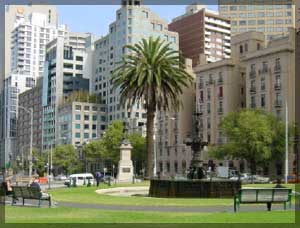
Introduction
and Context
The field of eco-psychology contends that humans have a profound need
for regular contact with the natural environment for continued wellbeing.
Indeed, it is believed that this need might even be as important as the
need to form close personal relationships (Kellert & Wilson, 1993).
People living and working in an urban setting are becoming increasingly
cut off from the natural environment, and this is seen as a contributing
factor to rising levels of stress and general dissatisfaction within modern
society (Shepard, 1995). The restorative power of even brief encounters
with nature is well documented (Kaplan & Kaplan, 1989), but there
are a number of factors that make these sorts of encounters difficult
in an inner city setting.
Looking back recently on the 6 years I spent living and working in various
concrete jungles around the world, I became aware that during this
time I had experienced minimal contact with nature. Holidays and weekends
were never spent camping or seeking out natural surroundings, and rarely
did I even eat lunch in a park. Perhaps I was limited by valid constraints,
or was I just blindly following the corporate norms that avoided the natural
world as a matter of course? Hindsight would suggest the latter is true,
and while I feel I have now freed myself from this "cycle of unconscious
nature avoidance", I am convinced that many people who exist within
the corporate world are still trapped in this unfortunate cycle.
The aim of this project is to understand the challenges people working
in the inner city face in maintaining a connection with nature, and the
extent to which they are able to recognise, and benefit from, the potential
restorative powers of this nature experience.
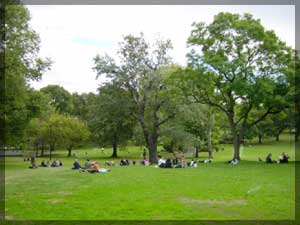
(Figure
1)
Sources
of Nature Connection
The notion of a nature connection experience probably conjures up images
of spending days on end hiking through forests or paddling down mountain
streams. While many other forms of nature experience exist, many believe
this deep form is essential to overall wellbeing. Some people living and
working in the city do manage to engage in this type of experience, however
many do not. Reasons for this vary. Some might claim not to have time
(despite taking long holidays at tourist resorts), while others might
prefer touring foreign counties to sample the culture. Many might claim
that they simply prefer the creature comforts, while there are those who
find it difficult to synchronise schedules with others seeking a similar
experience. Whatever the reason given, it seems that many living in cities
these days have simply fallen out of the habit of spending long
periods of time in nature.
Weekends, on the other hand, seem to provide people with a chance to spend
at least a few hours in nature on a more regular basis. Some are happy
to spend a few hours driving to escape the city and find a more natural
setting, where they can take day walks, go climbing, mountain biking or
horse riding. Others prefer to visit the coast, where they can walk, swim,
surf, sail or just soak up the sun. Winter months also offer a range of
alpine activities.
During the week, or for those unable to leave the city on weekends (possibly
due to time or financial constraints), there are still some inner city
or suburban options. Parks and reserves provide a natural (albeit often
man-made) setting where people can walk, jog, cycle, ‘rollerblade’
or simply relax. For most people living in the inner city, this is their
most common nature experience. For many, it is their only regular nature
experience. For these reasons, inner city parks were chosen as the main
setting for the research.
Lunch in the Park
Virtually everybody interviewed claimed to feel calming effects while
spending time in the park. Other words used included tranquil, serene,
peaceful, and haven – all this despite the fact that traffic and
other city noises were clearly audible from virtually all places respondents
were located, often on the periphery. It seems people were able to block
these distractions out, most likely helped by the fact that most people
faced the centre of the park, and away from the street (see Figure 2).
For some, this sense of calm enabled them to relax or unwind – sometimes
making it "hard to go back to work". Others saw the experience
as more rejuvenating or re-energising, something that "re-charged
their batteries" for the rest of the day.
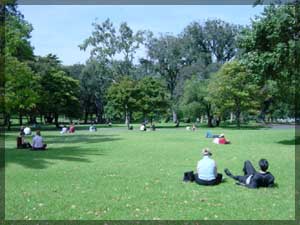
(Figure 2)
Some
insight could also be gained simply by observing behaviour in and around
the parks. They were virtually empty at midday, but started to fill soon
after, and were busiest around 1pm – the middle of most city workers’
lunch breaks. While many people simply sat to eat their lunch – both
alone and in groups – there were other activities such as backyard
cricket and Hackey Sack. There were joggers and power walkers, but there
were also two other distinct groups of walkers – those who, while
in running shoes, saw it as merely a mild form of exercise, and those
who simply strolled along at a leisurely pace enjoying the surroundings.
After about 1.30 things got quiet again, as people returned to their offices,
but some people stayed longer – obviously not constrained by the
usual office timetable. These people, who were typically dressed much
more casually than the office workers, also looked to be getting more
out of their visit than their hurried counterparts. They generally appeared
more relaxed, and often lay on the grass outstretched, even sleeping in
a few cases – something the city workers were less inclined to do
in their expensive corporate wardrobes.
On days when the weather was less favourable, there were distinctly fewer
people in the parks. People did not tend to sit on the grass, instead
preferring to sit on benches, paths, steps, or other man-made surfaces.
Joggers and power walkers were still evident, but the more leisurely walkers
were less common. In general, peoples’ visits appeared shorter than
on sunny days.
Importance Placed on Nature Connection
While most people claimed they tried to visit the park daily, their ability
to articulate the importance of these visits varied. Some felt they needed
to spend time in the park to enable them to "face the rest of the
day", while others attached little significance to the setting. On
the surface, this later group might appear to be simply creatures of habit.
However, the fact that they continue to return to the park might point
to a deep sub-conscious desire to connect with nature.
While some specifically identified nature as the important factor, others
said they simply enjoyed being outdoors – claiming to be equally
happy both in the park, and sitting on a bench in a paved, and essentially
nature-free, space. While it is possible that these people are truly able
to experience the same state of well-being in both settings , it is also
possible that they have simply failed to fully recognise or appreciate
the restorative effects of nature. Indeed, this sub-conscious denial of
the importance of nature resonates with many of the attitudes and beliefs
that have, throughout history, enabled mankind to destroy nature.
Interestingly, those who had grown up in a rural setting were most aware
of the importance of regular contact with nature, and the restorative
effects this contact can provide. Some also spoke of the connection with
their childhood that nature provided. Country people were also most aware
of the challenges associated with maintaining contact with nature in an
urban setting. Some even expressed concerns over the extent to which they
felt city people were "cut off from nature".
For a number of people, their visits to the park carried a social significance.
The park often represented a convenient place for friends working in different
offices to come together and socialise. For some, there was also the sense
that they preferred the park when it was reasonably busy (a few candidly
admitted to enjoying watching members of the opposite sex). If it was
too busy they found it less peaceful and relaxing, but settings like the
one shown in Figure 3 gave many a sense of isolation, and even raised
issues of security for some.
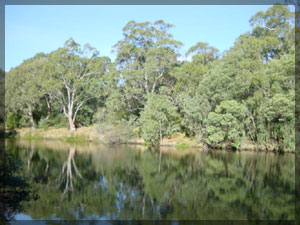
(Figure 3)
Nature
as a Religion?
Few people attached any spiritual or sacred significance to their visits
to the park. Some recognised, when prompted, that park visits shared some
similarities with visits to church – both provided time for reflection,
were calming, and gave a sense of peace. A few noted that both provided
a connection with their childhood. Another observation was that there
was a fundamental link between nature and God, the creator. For some this
gave nature a sense of the divine, although untouched wilderness was seen
as more divine than man-made parks, which were merely "inspired
by the divine".
The main differences that were identified between park visits (or nature
experience in general) and church reflected the formal nature of organised
religion. Most saw church as a time for prayer, where thoughts were focussed
on specific issues. For some, the fact that you were "not worshipping
anything" in nature gave nature experience less credence. A few people,
on the other hand, thought that time spent in church in between
services more closely resembled time spent in nature. Since the demands
placed on them during a formal service did not exist, they felt more able
to simply "chill out" as they can in nature. Some valued the
fact that while spending time in nature they did not have to worry about
"getting preached to" or "being roped into anything"
– a concern they sometimes felt while in mainstream churches.
Glimpses of Nature
While it is generally agreed that it is important to have at least some
longer-term or deeper nature experiences, the beneficial effects
of even small glimpses of nature should not be overlooked (Gallagher,
1993). Trees on city footpaths, flowers on nature strips, and even weeds
in the cracks are all reminders of the natural world. They enable us to
maintain a connection with nature in even the most urban of settings.
While it is believed that people benefit from these glimpses of nature
even if oblivious to their existence, it would seem reasonable to suggest
that the full benefits can only be felt through conscious experience
(sight, sound, touch or smell). Once people become aware of the importance
(and existence) of these glimpses of nature, they often find they are
more able to pay attention to them and experience their benefits.
Another interesting source of nature connection is the view. Views
have always been highly coveted, and this is reflected in the prices of
properties with views. While views of harbours, oceans, mountains, or
other natural settings are often preferred, even views of city skylines
are highly sought after. Views give the observer a perspective they cannot
normally experience at ground level – particularly in the city. While
the observer is not immersed in the scene (in fact distance, and the glass
itself, cuts them off from it), they are able to experience a sense of
the whole which can be quite uplifting. Interestingly, top executives
have always been rewarded with the best views. While views have been shown
to have some healing powers (Ulrich, 1984), the elusive corner office
is not an adequate defense against corporate burnout – perhaps a
reminder that glimpses of nature alone are not enough.
Conclusion
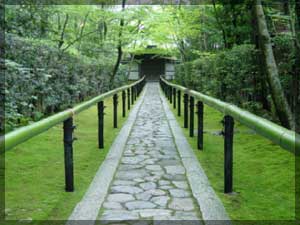
(Figure 4)
Many
people living and working in the inner city find it difficult to connect
with nature on a regular basis. When the sources of these difficulties
are explored further, it is clear that limiting factors are both real
and imagined. Imagined limiting factors generally reflect the low
priority placed on nature experience, largely because its importance is
not widely recognised. In many cases, real limiting factors are
non-trivial – however there are a range of alternatives to traditional
nature experience (such as glimpses of nature and nature substitutes)
which still offer beneficial effects. Indeed, many daily activities offer
potentially restorative effects, but these effects are reduced if people
are not consciously aware of the experience, and the extent to which it
can be beneficial. Re-mystifying the everyday should enable people
to experience the sacred in the concrete jungle.
References
Baker, B. (2002) ‘Happy by Nature’, The Washington Post,
June 4, p HE01
Gallagher, W. (1993) The Power of Place, Poseidon Press, New York.
Kaplan, S. and Kaplan, R. (1989) The Experience of Nature: A Psychological
Perspective. Cambridge University Press, New York.
Kellert, S. and Wilson, E. O. (1993) The Biophilla Hypothesis.
Island Press,
Washington DC.
Mehrabian, A. (1976) Public Spaces and Private Places, Basic Books,
New York.
Shepard, P. (1995) ‘Nature and Madness’ in Roszak, T, Gomes,
M & Kanner, AD (eds) Ecopsychology. Sierra Club, San Francisco.
Ulrich, R. S. (1984) ‘View Through a Window May Influence Recovery
From
Surgery.’ Science, v224, p420.
|
|














